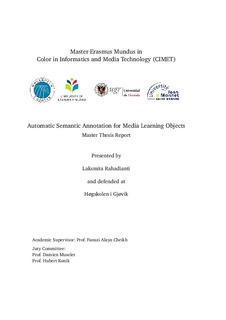Automatic Semantic Annotation for Media Learning Objects
Master thesis
Permanent lenke
http://hdl.handle.net/11250/143742Utgivelsesdato
2012Metadata
Vis full innførselSamlinger
Sammendrag
Recent advances in technology have provided alternative solutions and approaches to everyday tasks. One of which is in education, where the learning process is no longer confined to conventional classrooms. E-learning or distance learning are now a popular alternative which involves the use of learning objects for teachers to convey instructional content. These learning objects are accessible to students on a digital repository and can come in many different forms. Recently multimedia files such as videos are also used. In order to enable efficient indexing and retrieval of these videos, they must be encapsulated into effective media learning objects. Although many querying methods exist, users are most accustomed to query by keyword methods, giving text based queries to retrieve corresponding videos. Generally these keywords are selected manually, but this method is not favorable because manual annotation is restrictive to a set of words, subjective to the annotator, and overall a labor intensive process. This research explores semantic keyword selection methods for automatic video annotation. Cross document annotation is used to extract potential keywords by taking into consideration surrogate documents, e.g. transcript, slides, lecture notes, etc. These potential keywords are then refined based on a set of preselected seed words in order to obtain highly related keywords, based on WordNet and visualness similarity scores. Three novel objective scoring methods are proposed to select top-ranking keywords based on visualness similarity and word sense disambiguation. These developed methods are then evaluated based on questionnaire responses of selected keywords for a set of videos. The three developed objective scoring methods correlate well with the scores of the subjectives responses and generally outperform the traditional term frequency inverse document frequency (TF-IDF) method. The proposed LVD-F method obtains the highest precision and recall of all.
